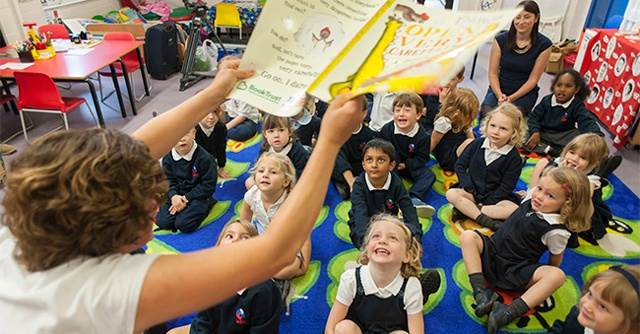Hints and tips for storytellers
Published on: 13 January 2017 Author: Bookstart Team
Storytelling can be a scary business. A bit of planning, plenty of practice and bucketloads of enthusiasm can make all the difference, says Simon Bond, Library Assistant at Pontefract Library.

Reading aloud to children is our bread and butter and should be a special treat for both reader and audience, but not everyone feels confident or comfortable when it comes to storytelling. Here are some hints and tips help you face your fears and make the most of the experience.
Think of storytime as a tale in three parts...
The beginning
Preparation is the key to a successful story session, particularly if you're feeling a little bit out of your comfort zone. Control the things you can control and the job's half done:
- Choose the book/s you're going to read carefully. Advice and suggestions are nice but only use books that you have chosen and feel happy with. Think especially of length and language. Do they lend themselves to being read aloud? Generally, the shorter and simpler, the better.
- And don't forget size - an oversized picture book is great visually but not much use if you end up sat at the front wrestling with it!
- Make sure you know your audience in terms of age and ability. There's no point reading a long, wordy story to under 5s, or a board book to a year 6 class (though they'd probably enjoy it!). If it's a group you've never read to before you could always ask teachers/carers for advice on age-appropriate material.
- Timing is important. How long is the session expected to last and do you have enough material to fill the time? Children get fidgety quickly, so the short and simple rule applies again - two or three short books are better than one longer story.
- Think about location. Reading a story in the children's library is wonderful but be aware of distractions such as books or toys within easy reach. It can be a good idea to designate a special 'story' rug or mat for the children to sit on. Where will you sit? A chair a little higher than the children is a good idea so they can all see you (and you can see them!).
- Look for places in the book where you can use voices or noises and dramatic pauses. Feel free to use gestures and actions to enhance the story. Vary your vocal style, too - if the story calls for a silly voice, do a silly voice; if it needs you to act frightened, act frightened.
- Practise reading your chosen books out loud. Practise again. Then practise some more. It really does make perfect.

The middle
Now for the scary bit – it's time to read.
- Warm up your voice. You wouldn't run a mile without warming up first so why go into a storytime 'cold'? Your voice is a delicate instrument and you can easily strain it, particularly if you're nervous. Take a few minutes to exercise - recite the alphabet, make some vowel sounds, whisper and whistle, pull a big face, pull a little face. You'll feel a bit silly but you'll notice the difference.
- However nervous you're feeling inside, try to look happy and confident. You've got a STORY to share and it's going to be GREAT!
- Sometimes the audience needs warming up, too. Nothing will set your nerves on edge like a group of children sat in absolute silence. So before you start, get them to shout their names out, ask them if they're ready for a story, anything. Then make them do it again louder - the children will loosen up (and so will you).
- Read clearly and slowly. If you're nervous you'll tend to speed up, often without realising.
- Make eye contact. Putting your head down and just ploughing through it will kill the event stone dead.
- Use recurring words and catchphrases to get the children involved e.g. 'There's a shark in the park!' There are three things children love most when having a story read to them: repetition, repetition and repetition.
- Encourage the children to respond to the words and pictures and don't be afraid to go off script e.g. 'Who's afraid of sharks?' 'And what do you think happened next?' Get them to roar like lions or hiss like a snake. A story session is interactive, so interact.
- But be careful of letting things go off on a tangent. Remember, you're in the chair, you have the book. If the children get overexcited, simply put the book aside until they quieten down.
- If you're nervous about reading in front of adults - parents, teachers etc - don't be. Either make them join in or ignore them.
The end
Breathe a sigh of relief and pat yourself on the back - it's over! Take time to review the session and think about what worked and what didn't.
- If things went well, brilliant. Whatever you did, keep on doing it.
- If things didn't go so well try to work out why. Perhaps you chose the right book for the wrong class. Perhaps the children were unresponsive. Maybe you just had an 'off' day. It happens. Learn from it, put it behind you, move on.
But always remember, when it comes to delivering a storytime, play to your strengths (and yes, you do have them!). No two readers are alike. Some are natural performers, others are better at just being themselves. There is no 'right' way to read a story. Just your own way.
And finally...
If it helps, here's a cheesy acronym as a quick reminder of the essentials.
Think STORY:
Select your material
Target your audience
Organise and practise
Read, repeat, react, respond
You're a success, enjoy it!
The last of these is the most important of all. If you have fun telling stories, it's an absolute guarantee that children will enjoy hearing them!





